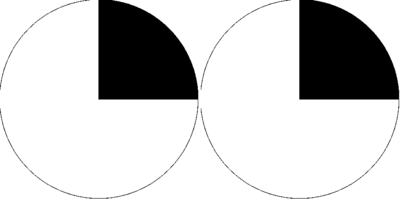Quadrantanopia
| Quadrantanopia | |
|---|---|
 | |
| Right homonymous superior quadrantanopia. The areas of the field lost in each eye are shown as black areas. This visual field defect is characteristic of damage to Meyer's loop on the left side of the brain. | |
| Classification and external resources | |
| Specialty | ophthalmology |
| ICD-10 | H53.4 |
| ICD-9-CM | 368.46 |
Quadrantanopia, quadrantanopsia, or quadrant anopia refers to an anopia affecting a quarter of the field of vision.
It can be associated with a lesion of an optic radiation.[1] While quadrantanopia can be caused by lesions in the temporal and parietal lobes, it is most commonly associated with lesions in the occipital lobe.[2] If Meyer's loop (temporal pathway) is lesioned, the vision loss is superior (colloquially referred to as "pie in the sky"); if optic radiation (parietal pathway) is lesioned, the vision loss is inferior.[3]
Homonymous inferior/superior quadrantanopia
Homonymous (denotes a condition which affects the same portion of the visual field of each eye) inferior quadrantanopia and Homonymous superior quadrantanopia are a loss of vision in the same lower or upper quadrant of the visual field in both eyes - either the left lower/upper quadrant - left homonymous inferior/superior quadrantanopia - or the right lower/upper quadrant - right homonymous inferior/superior quadrantanopia.[4]
Homonymous binasal/bitemporal quadrantanopia
NB Homonymous means 'affecting the same side on each eye'. You cannot? have a homonymous binasal anopia. This is just 'binasal anopia'. Binasal (either inferior or superior) quadrantanopia affects the inner visual quadrants closer to the nasal cavity in both eyes. Bitemporal (either inferior or superior) quadrantanopia affects the outer visual quadrants in both eyes.
Characteristics of quadrantanopia
An interesting aspect of quadrantanopia is that there exists a distinct and sharp border between the intact and damaged visual fields, due to an anatomical separation of the quadrants of the visual field. For example, information in the left half of visual field is processed in the right occipital lobe and information in the right half of the visual field is processed in the left occipital lobe.[2]

In a quadrantonopia that is partial, there also exists a distinct and sharp border between the intact and damaged field within the quadrant. The sufferer is able to detect light within the damaged visual field.
The prospects of recovering vision in the affected field are bleak. Occasionally, patients will spontaneously recover vision in the affected field within the first three months after the brain injury; however, vision loss remaining after this period of spontaneous recovery is traditionally thought to be permanent, certain companies now claim to be able to induce recovery of vision after this three-month period.[5]
Compensatory behaviors
Individuals with quadrantanopia often modify their behavior to compensate for the disorder, such as tilting of the head to bring the affected visual field into view.[6] Drivers with quadrantanopia, who were rated as safe to drive, drive slower, utilize more shoulder movements and, generally, corner and accelerate less drastically than typical individuals or individuals with quadrantanopia who were rated as unsafe to drive. The amount of compensatory movements and the frequency with which they are employed is believed to be dependent on the cognitive demands of the task; when the task is so difficult that the subject's spatial memory is no longer sufficient to keep track of everything, patients are more likely to employ compensatory behavior of biasing their gaze to the afflicted side.[7] Teaching individuals with quadrantanopia compensatory behaviors could potentially be used to help train patients to re-learn to drive safely.
References
- ↑ Yale- Cranial Nerve 2, pg. 11 Archived June 7, 2008, at the Wayback Machine.
- 1 2 Kolb, B & Whishaw, I.Q. Human Neuropsychology, Sixth Edition, p.361; Worth Publishers (2008) ISBN 978-0-7167-9586-5
- ↑ Central Visual Pathways Archived March 10, 2008, at the Wayback Machine.
- ↑ William J. Weiner: Neurology for the Non-Neurologist, p.526; Lippincott Williams & Wilkins (July 2010) ISBN 1605472395
- ↑ Rehabilitation for Homonymous Hemianopia and Quadrantanopia Archived July 1, 2013, at the Wayback Machine.
- ↑ Visual Fields in Brain Injury - Hemianopsia.net Everything you need to know about Hemianopsia
- ↑ Wood JM, McGwin G, Elgin J, Vaphiades MS, Braswell RA, DeCarlo DK, Kline LB, Owsley C (2011). "Hemianopic and quadrantanopic field loss, eye and head movements, and driving". Invest. Ophthalmol. Vis. Sci. 52: 1220–5. doi:10.1167/iovs.10-6296. PMC 3101691
 . PMID 21367969.
. PMID 21367969.
External links
| Wikimedia Commons has media related to Quadrantanopia. |
- Quadrantanopsia Visual Fields Teaching Case from MedPix